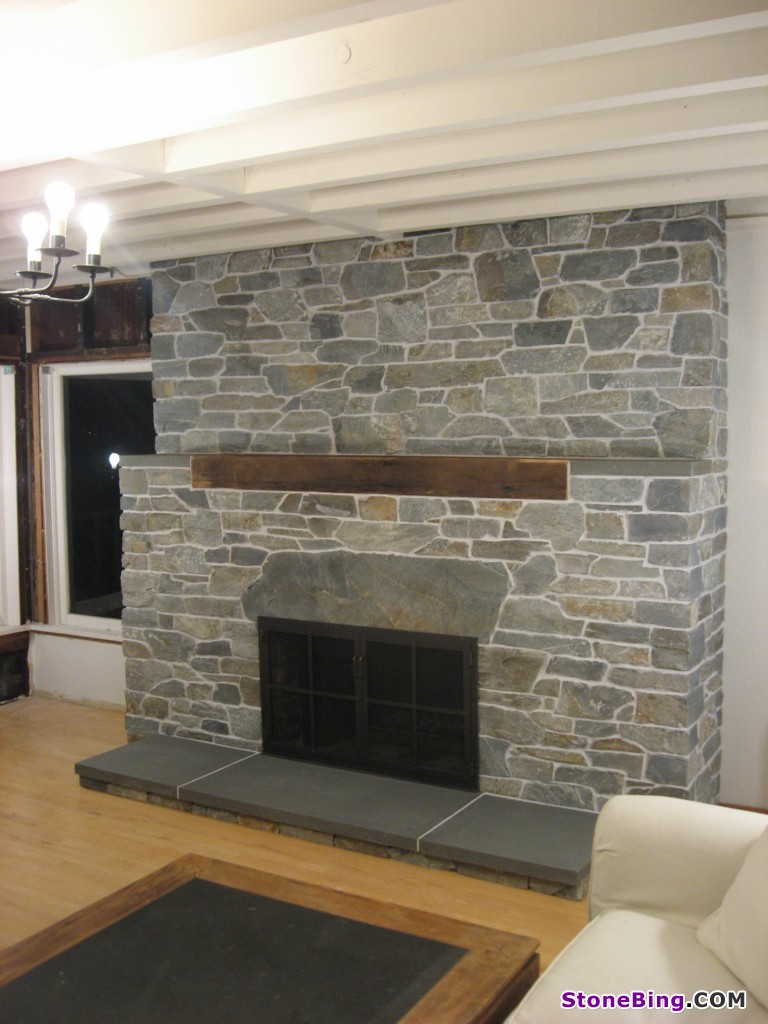
Size
First of all, is the area being covered very large? Does it go completely floor-to-ceiling or is it chest-high? Are your ceilings extra high, or a standard 8′ or below? Is the footprint of the fireplace very wide and deep? In other words, what is the total square footage of surfaces being covered?
While an average exterior stone veneer can cost between $60-80 per square foot (on a large, flat surface with no corners or interrupting features like windows, etc.), a high-quality fireplace veneer will be something more like $80-100 per square foot. This is mainly because it will be seen up close on a daily basis, and therefore it must be gorgeous. This can be used as a kind of base price along with $10-15/sf for any demolition or surface preparation and $45-50/sf for 2″ capping slabs (like hearthstone). The following considerations can modify the price further.
What is the design?
Though some fireplace designs are basically one big rectangular box, most are more complex than that. Just a quick perusal of stone fireplaces on the internet will reveal the diversity of styles that are out there. Which style is the best for your house? If you have not put much thought or research into the matter, you may need your contractor to help you create a design (this becomes part of the price, though oftentimes it is not spelled out as such). It is worth the time spent making a design – you and your builder will know what is expected so there are no misunderstandings.
Design elements such as a curved firebox arch, an extra-thick hearth stone or mantel, or an artistic pattern in the stone coursing, also greatly affect the pricing. Though these details may seem like an easy-enough addition, they almost always have a major impact on the time scale of the project. Expect an additional charge beyond the straight veneer pricing for ornamental details.
Materials
There are several ways that your choice in materials can effect things. Mainly, are you using natural stone or a manufactured product such as brick, tile or cultured stone? I normally do not recommend cultured stone as a fireplace material, unless you are matching an existing veneer. It does not stand up to close inspection very well. Instead, use one of the many natural thin veneer products that are available. These are made from full-size ledge stones that have the face surfaces sliced thinly off for use.
Better yet, use full-thickness stone materials like in the old days. Though the thin veneer looks very convincing, it barely competes visually with a thick veneer which allows the mason to pull stones from a much larger pool of shapes and sizes. This makes for a more dramatic layout of stones, and the more sturdy and solid the structure looks, the better. The restriction here is in the weight requirements of your house framing and/or structural masonry – reinforcement may be necessary.
New Construction or Remodel?
If your fireplace is going into a new, unfinished home (or even a gutted remodel), the mason is free to work in an unfettered way because he is walking on a plywood substrate floor. And the resulting dust and slurry is in no danger of falling on a fine-finished floor or new carpet. I cannot begin to tell you how much of a luxury that is to a fireplace contractor, and it is worth a certain amount of bargaining in the price.
Conversely, if the fireplace is going into an existing house in which a lot of care must be taken to keep things absolutely clean and uncluttered during the entire process, that will reflect in the price as well. The distance between the fireplace and the saw area makes a difference too – eg. if there is a flight of stairs to climb, it will receive many dozens of trips up and down its steps in one day, and that adds up.
Artistry
Who is building your fireplace surround? Does this person know how to make the stones come together in a way that is pleasing to the eye? There are many people who are willing to follow the steps to make something like this, but it takes years to develop the skills to make it look right. And when it is masonry that is being installed, it will be there forever (potentially), so it had better look good!
By the same token, make sure that you are getting what you pay for in terms of structural integrity and functionality. If someone is offering a low price, they may be cutting corners on the install and skipping important steps of the process.







